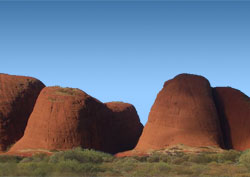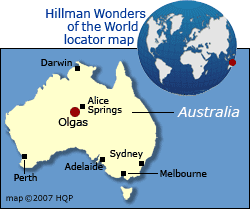The Olgas / Kata Tjura
 Why
The Olgas
are special
Why
The Olgas
are specialThe Olgas (Kata Tjuta) of Australia thrust up from the desert plain, creating a cluster of 36 tall, steep-sided rusty-red domes tightly separated by deep gorges and narrow valleys.
The Olgas tips and insights
Taller than they seem
They are much higher than they appear in photographs. The tallest rises 348 meters (1148 feet) above the flat desert and is appreciably higher than its regional neighbor, Ayers Rock.
How they were carved
The Olgas' smooth surfaces were sculpted by winds over millions of years.
Colorization
They are situated about 50 kilometers (30 miles) west of Ayers Rock in Australia. Like the latter, The Olgas vividly change colors as the day passes. At sunset, the rocks become glowing orange-tinted red. Nature puts on a colorful show at sunrise, too.
Holy
Also like Ayers Rock, The Olgas are sacred to the local Anangu Aborigines - and many visitors sense that spirituality.
When to go
The best seasons for visiting The Olgas are the austral spring (September to November ) and fall (March to May). Temperatures top 40°C (104°F) in the summer (December to February) and drop below freezing in the winter (June to August).
Name
The Olgas were named in honor of the Queen of Spain after people of European descent "discovered" it in 1872.
Kata Tjuta (kah-tah tzhoo'-tah) is the local Anangu Aborigine people's name for The Olgas. It means "many heads".
Today, Kata Tjuta, no longer Olgas, is the official name. I use the old name on my website because the vast majority of international travelers know it only by that name.
Trails
The Olgas have two major walking trails. Each lets you see this wonder up close:
-
Valley of the WInds
The 7 kilometer (4 mile) loop trail takes 3 to 4 hours. It has two excellent viewpoints.
- Olga Gorge
This "go there and doubleback" trail is quicker and easier, though somewhat less stunning. It's about 2 kilometers (1 mile) in length.
Location in Australia



